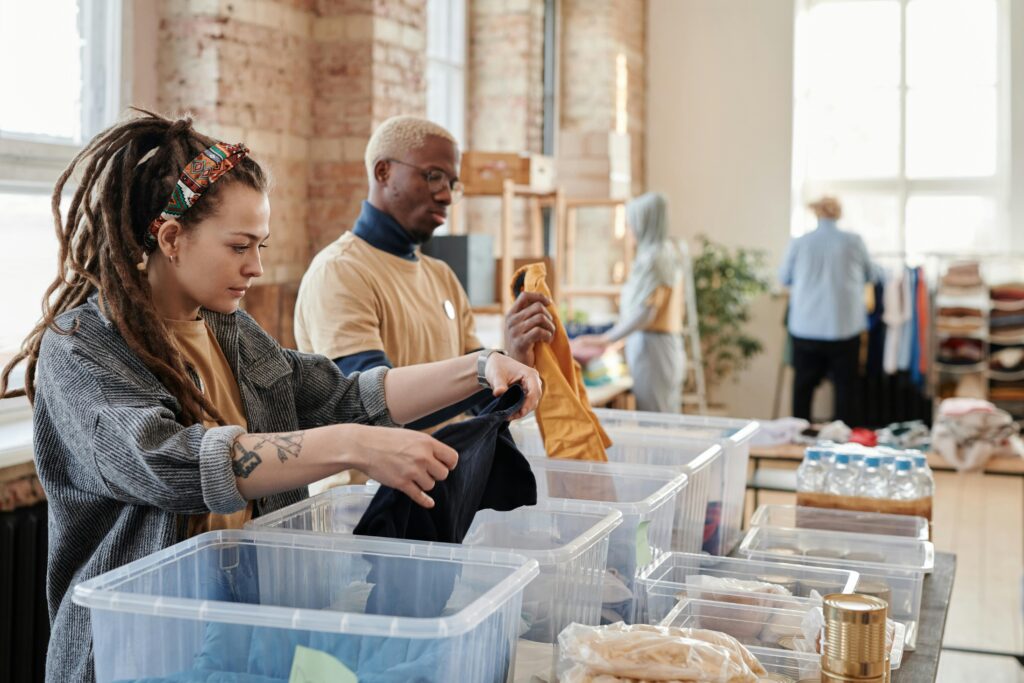Rather listen? Simply hit the play button and listen to the article in full
- Your help matters 00:00
Linda Harrison on why fewer retired people are becoming volunteers – and the impact this has on charities
Twice a week at 7.30am, you’ll find Brenda Marsh walking the ward of Moorfields Eye Hospital. Brenda isa hand-holding volunteer in the London hospital’s operating theatres, meeting and greeting patients. After finding out how they’re feeling, she asks if they’d like a hand to hold throughout their operation.
“This usually breaks the ice, then they open up and I can find out how stressed and anxious they are,” says Brenda. “I meet a lot of very scared patients.” Brenda started volunteering at the Friends of Moorfields charity in May 2022 after retiring and finds it very rewarding. “I cannot believe how much just a simple gesture of holding someone’s hand through an operation can help and mean so much to patients,” she says. “And how grateful they are for this act of kindness. “I absolutely love volunteering and I take a lot of patients home in my heart.
One lady after surgery thanked the surgeon for looking after her eyes, and me for looking after her soul. It is a very humbling job that feel privileged to be able to do. Anyone of any age can – and should – as the rewards are truly amazing.” However, while many people still give up their time to help others, volunteering is at a record low. A recent government Community Life Survey found that just 16% of people in England take part in formal volunteering at least once a month – compared with around 28% in 2013. Moorfields itself has a healthy number of older volunteers, including former patients like Brenda. But many other charities are struggling to recruit older volunteers in the numbers they’ve previously relied on. So, what’s behind the change?
FareShare Midlands
FareShare Midlands is one charity affected by this. In partnership with FareShare UK, it rescues good-quality surplus food and redistributes it to more than 800 local charities and community organisations, reaching 83,000 people weekly.
Paul Akroyd, FareShare Midlands’ head of volunteering and employability, says: “We receive surplus food from supermarkets, farms and food suppliers into our three depots. There it is sorted, stored and redistributed… This includes [to] food banks, children’s clubs, homeless shelters and community kitchens. “We rely heavily on volunteers, the vast majority of whom are older and semiretired or retired. We were at a point last year when we almost had to stop making deliveries to our members – local charities and community organisations – as we had no volunteers to drive delivery vans.”
There are various reasons for decreasing volunteer numbers, not least the cost- fliving crisis. Paul explains: “Many charities have found that rising numbers of older volunteers who had been able to live comfortably on their pensions – potentially 10% across the UK – have found they’ve had to return to some form of paid work. “An even greater number of senior volunteers – potentially 60% – have adult children who are parents themselves.
The current economic climate means that frequently both parents have to work, and childcare is costly. Therefore, older people who might have been willing and able to afford to volunteer are not doing so as they are supporting their children by providing free childcare.”
This is a growing trend in the sector. In Greater Manchester and Birmingham, the charity Home-Start has experienced a huge drop in volunteers in recent years because rising childcare costs mean more people are looking after grandchildren. The charity helps young families by offering emotional and practical support in their own homes for anything from poverty to illness, disability or bereavement. Volunteers offer a listening ear, a shoulder to cry on and practical help. Retired or older volunteers, once the core of HomeStart’s home-visiting volunteers, now have little time free for volunteering. It’s a similar situation at national charity Coram Beanstalk, which helps children in schools who need extra support with reading through one-to-one support. More than 80% of its volunteers are aged 55 and over. In 2024, the charity saw a 20% decline in applications to help – 49 schools are currently waiting for volunteers.
Amy Lewis, who leads Coram Beanstalk, says volunteers today are looking for different types of roles. “Many seek shorter term or micro roles to better fit with other commitments,” she explains. “I’ve worked with the charity for over 13 years and have seen it become more difficult to find suitable volunteers for our role to help children become readers. Historically, we were able to find people who could commit twice a week, which was really appreciated by schools. We can no longer do this and have had to adapt our role to weekly visits. “Care for grandchildren has impacted on the time people can give, but also many are looking after parents who are living longer and unable to access suitable care. In the past year, we lost 14% of our volunteers due to family commitments.”
Technology is also a barrier to volunteering. Making Space is a national health and social care charity that runs services such as extra care housing schemes, carer support groups and mental health services. It currently has around 70 volunteers, most aged 70 to 90. Volunteer coordinator Antonia Pike says: “Time constraints mean our volunteering opportunities are generally now only advertised online. So if an older person doesn’t have access to the internet, they may not find out about us.”
Value of life experience
Making Space is seeing more applications from 16 to 18-year-olds – many as part of their T Levels (practical A Levels), others who want to improve their CVs. But this also presents challenges. Antonia explains: “These younger volunteers bring energy, enthusiasm, academic skills and expertise in IT and social media, but often lack the communication skills and confidence we’ve come to expect from older volunteers. They can be reluctant to pick up a phone or chat to people they don’t know. There’s no beating a bit of life experience.”
Many charities are reacting by trying to make volunteering more flexible. Amy says: “We try to minimise time needed for learning and development by offering a range of ways to connect, including online group sessions and a resource portal. “Volunteering can bring new purpose to people’s lives post-retirement – schools value the life experience and patience older volunteers bring to children; and volunteers say the time spent with children keeps them young!”
Volunteering can also boost older people’s confidence and sense of worth, help with fitness and mental wellbeing, and reduce isolation and loneliness. “It’s about what you can give, but it’s also about what you get back,” says Antonia. “For many older volunteers, it can be a way to rediscover their identity and interests.”
Further Information
• National Council for Voluntary Organisations: www.ncvo.org.uk
• Doit: www.doit.life
• The Big Help Out: www.thebighelpout.org.uk
• Making Space: www.makingspace.co.uk/get-involved/volunteering
• Moorfields Eye Hospital: www.moorfields.nhs.uk/
• FareShare: www.faresharemidlands.org.uk/volunteer
• Coram Beanstalk: www.corambeanstalk.org.uk
• Home-Start: www.gmhomestarts.org.uk www.homestartbirmingham.co.uk
How to volunteer near you
- Consider what you enjoy, your passions and interests, and how you might use your own life experience to help others. Research local charities and find one that sits well with your own values.
- Be realistic about how much time you can commit, and make sure it can fit into your routine.
- Look for organisations offering structured roles and good support.
- Don’t worry about qualifications or work history – it’s your life experience that makes you a valuable volunteer.
- Not online? Call in to your local volunteer centre (most towns have one), which can match you to an opportunity.






